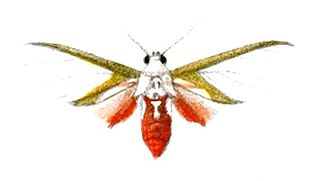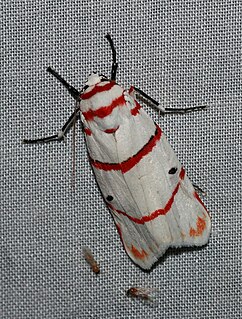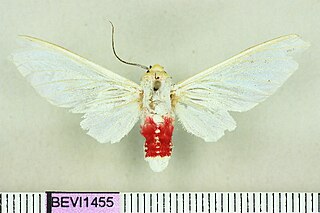
Camarasaurus was a genus of quadrupedal, herbivorous dinosaurs. It was the most common of the giant sauropods to be found in North America. Its fossil remains have been found in the Morrison Formation of Colorado and Utah, dating to the Late Jurassic epoch, between 155 and 145 million years ago.

Eupseudosoma is a genus of moths in the family Erebidae. The genus was erected by Augustus Radcliffe Grote in 1865. The best known and most widespread species is Eupseudosoma involutum, the snowy eupseudosoma, a bright white moth which is found from the southern United States right down to the south of South America. There are a few other species found across the Americas.
Baritius is a genus of moths in the family Erebidae. The genus was erected by Francis Walker in 1855.

Cyana is a genus of moths in the family Erebidae. Species are well distributed in Africa, Madagascar, China, India, Sri Lanka, Myanmar, Sumatra, Java and Borneo. The genus was erected by Francis Walker in 1854.
Echeta is a genus of moths in the family Erebidae. The genus was erected by Gottlieb August Wilhelm Herrich-Schäffer in 1855.

Halysidota is a genus of moths in the family Erebidae. The genus was erected by Jacob Hübner in 1819.
Hyaleucerea is a genus of moths in the subfamily Arctiinae. The genus was erected by Arthur Gardiner Butler in 1875.

Leucanopsis is a genus of moths in the family Erebidae. The genus was described by Alfredo Rei do Régo Barros in 1956.

Paranerita is a genus of moths in the family Erebidae erected by George Hampson in 1901.
Zatrephes is a genus of moths in the family Erebidae. The genus was erected by Jacob Hübner in 1819. It was formerly considered part of the Arctiidae. It includes the former genus Ennomomima, which is now considered a synonym.
Tessella is a genus of moths in the family Erebidae. The genus was described by Breyer in 1957.

Trichromia is a genus of moths in the family Erebidae erected by Jacob Hübner in 1819. The members of this genus are largely indigenous to South America.
Baritius affinis is a moth of the family Erebidae first described by Walter Rothschild in 1910. It is found in Brazil, French Guiana and Amazonas.
Baritius eleutheroides is a moth of the family Erebidae first described by Walter Rothschild in 1909. It is found in Brazil, Peru, Suriname, French Guiana, Venezuela, Ecuador and Costa Rica.
Baritius flavescens is a moth of the family Erebidae first described by Walter Rothschild in 1909. It is found in Brazil.
Baritius hampsoni is a moth of the subfamily Arctiinae. It was described by Paul Dognin in 1902. It is found in Costa Rica and Peru.
Baritius sannionis is a moth of the family Erebidae. It was described by Walter Rothschild in 1909. It is found in French Guiana, Brazil, Ecuador, Peru, Bolivia and Costa Rica.

Eupseudosoma grandis is a moth of the family Erebidae first described by Walter Rothschild in 1909. It is found in Peru.
Paranerita grandis is a moth of the subfamily Arctiinae. It was described by Walter Rothschild in 1909. It is found in Peru.






